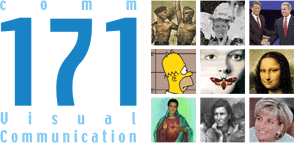
Office: HGH 210; phone: (408) 924-5378
Email: wooda@email.sjsu.edu
Web: http://www.sjsu.edu/faculty/wooda
 |
Dr. Andrew Wood Office: HGH 210; phone: (408) 924-5378 Email: wooda@email.sjsu.edu Web: http://www.sjsu.edu/faculty/wooda |
Visual communication encompasses a range of topics, including the use of icons to explain complicated concepts, the creation of posters to inspire political fervor, and the crafting of buildings to articulate cultural ideas. Indeed, while students of communication studies may be forgiven for privileging speech as their primary medium of expertise, we employ visual communication to articulate abstractions, invoke passions, and shape human relationships. Moreover, this skill must not be found only in the hands of so-called experts. Photography, video equipment, and computer technologies have made it possible for virtually any person or group to construct, edit, and distribute images worldwide. Clearly, many effective communicators employ the power of images to craft their ideas.
However, many of us find it difficult to communicate our responses to an increasingly visual world. We struggle to explain, critique, or resist the images that confront us through newspapers, advertisements, television shows, films, architecture, and other contexts. We discover the complexity behind this simple question: what do images do to us, and how shall we respond to them? This class offers one response to visual communication by exploring the ideological meanings that images convey. Transcending the mere evaluation of aesthetics, we seek to develop a language to enable our intelligent analyses of visual communication as a site where public life becomes enacted and contested. To that end, this course concentrates on three areas:
• The relationship between truth, beauty, and power within visual communication
• The mass production of images that evoke fantasies of public life and personal transcendence
• The transition from modern to postmodern architectural forms
Our objectives - Successful conclusion of this class means that you can:
• Apply semiotic analysis to unpack the ideological meanings of visual communication
• Employ varied forms of gaze theory (eg., class, gender, postcolonial, discursive) to analyze visual communication
• Differentiate and explicate the social meanings of various forms of modern architecture
Primary Readings
Blair, C., Jeppeson, M.S., & Pucci, E. (1991). Public memorializing in postmodernity: The Vietnam veterans memorial as prototype. Quarterly Journal of Speech, 77(3), pp. 263-288.
Sturken, M, & Cartwright, L. (2001). Practices of looking: An introduction to visual culture. New York: Oxford University Press.
| Toolbox
| | |
|